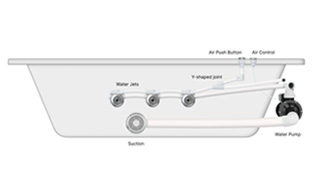Hot tub plumbing systems can be categorized into water lines and air lines, both of which serve different functions and have fundamentally different requirements for hoses:
1.Water Lines
These are the main pipes carrying water through your spa, from filter to pump, pump to heater, and heater to jets. They also connect to features like waterfalls. For these, larger hoses or pipes (often 1" flex or rigid PVC) are standard.
2.Air Lines
Jets often mix water with air for stronger massage. Airlines move air from a blower or venturi intake to the jets. These are smaller, usually 1/4".
Key needs: no large water flow, but smooth airflow and easy bends without kinking.
Plan Your Plumbing Layout
A smart layout keeps water pressure strong and jets powerful. A poor layout, on the other hand, can leave jets weak and uneven.
1.Keep lines short
Use two shorter runs instead of one long stretch. This reduces flow resistance and pressure loss.
2.Go with terminal lines
Direct connections from pipe to jet are more efficient than loop systems that circle back to the main line.
Match the Right Pressure Rating
Hot tubs are pressurized systems, so hoses must meet the right pressure grade.
1.Why it matters
A regular drain or sewer pipe from a hardware store won't hold up in a hot tub.
2.Typical ratings
Class C (100 PSI ) works well for most builds.
PS:Always check your spa system's specs (manual or manufacturer) and match hoses accordingly.


































